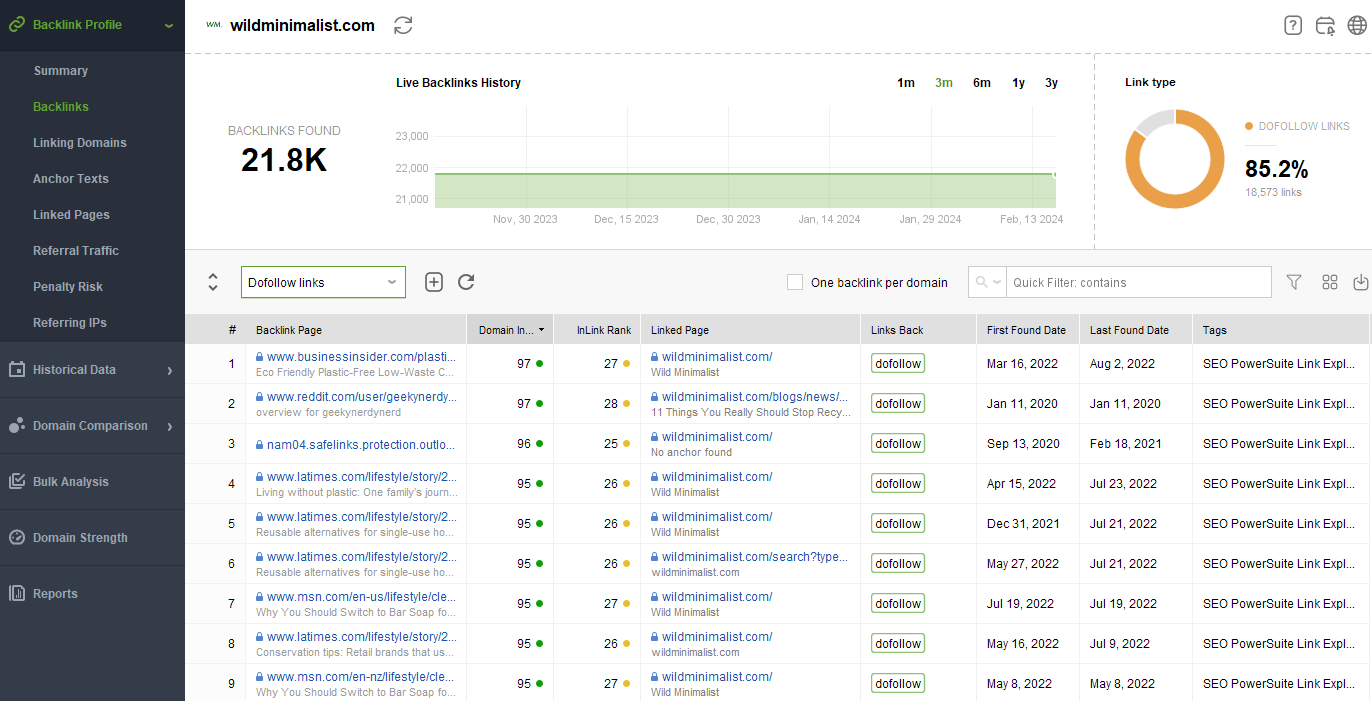
What Are Manipulative Links? Defining & Overcoming the Challenge for Your Website's SEO Success

What Are Manipulative Links? Defining & Overcoming the Challenge for Your Website’s SEO Success
Disclaimer: This post includes affiliate links
If you click on a link and make a purchase, I may receive a commission at no extra cost to you.
Unnatural link
Contents
- Unnatural links definition
- Unnatural links examples
- Unnatural links and SEO
- How to detect unnatural links
- How to stop spam backlinks
- Natural links and SEO
- Related links
Unnatural links definition
An unnatural link is a type of link that is intended to manipulate the ranking of a website in search engine results . Such practices contravene Google’s Webmaster Guidelines, and sites employing these tactics may face penalties .
Unnatural links are not genuinely endorsed or intentionally placed by the website’s owner. They can range from overly optimized anchor text links, promotional content that influences PageRank, to concealed or substandard links within widgets, among others.
A typical form of an unnatural link is a paid link, where a site compensates another entity for a “follow” backlink directing to their site.
The criteria for what constitutes an unnatural link can be somewhat ambiguous. For instance, it’s predominantly the excessive swapping of links or extensive guest posting efforts that fall into the category of unnatural. Likewise, adding your site to a miscellaneous or irrelevant directory might also be considered an unnatural link.
Google is continually enhancing its algorithms to automatically detect and mitigate the impact of unnatural links.
Unnatural links examples
Unnatural links can include, but are not limited to:
- Link farms: A link farm is a group of websites that are created specifically for the purpose of linking to other websites. These links are often low quality and do not provide any value to users.
- Excessive link exchanges: Swapping links with other sites in a quid pro quo manner beyond what could be considered natural or reasonable.
- Purchased links: Links bought for the purpose of passing PageRank or manipulating SERP rankings. This includes paying for links directly or through services.
- Large-scale article marketing or guest posting campaigns: These startegies can be detected by over-optimized, keyword-rich anchor texts.
- Automated link building: Some people use automated tools to generate large numbers of links to a website.
- Text advertisements that pass PageRank: Paid advertisements that are designed to pass PageRank, as opposed to those that are clearly marked as advertisements and use the nofollow attribute or are otherwise separated from natural PageRank-passing links.
- Low-quality directory or bookmark site links: Links from directories or bookmarking sites of low quality that are created just for SEO link building.
- Hidden links: Some people attempt to hide links on their website by using small font sizes, the same color as the background, or other methods.
- Hidden text: Some people attempt to hide text on their website that is designed to manipulate search engine rankings. This text is often the same color as the background or is hidden using other methods.
- Widely distributed links in the footers or templates: Links that appear in the footers or templates of various sites, often with keyword-rich anchor text, that do not occur naturally.
- Forum comments with optimized links: Using forums to create links by adding optimized links in your post or signature in a way that is not natural to the conversation.
Unnatural links and SEO
Using unnatural links can have negative consequences for a website’s search engine optimization (SEO ). Search engines like Google use algorithms to determine the relevance and authority of a website , and one of the factors they use to do this is the number and quality of links pointing to the website.
If a website is found to be using unnatural links to manipulate its search engine rankings, it can be penalized by the search engine. This can result in the website’s search engine rankings being lowered, or the website being removed from the search engine’s index altogether.
In addition to the direct impact on a website’s search engine rankings, using unnatural links can also harm a website’s reputation. If a website is seen as trying to manipulate its search engine rankings through spammy or deceptive tactics, it can damage the trust of its users and its overall credibility.
To avoid these negative consequences, it is important for website owners to follow search engine guidelines and only get links from reputable sources.
How to detect unnatural links
Detecting unnatural links pointing to your website is crucial for maintaining your site’s backlink profile and search engine rankings. Start by utilizing backlink analysis tools such as SEO SpyGlass . This tool can help you get a comprehensive view of your site’s backlink profile, showing you the sources of your backlinks. Review the list of domains linking to your site. Look for patterns that might indicate unnatural linking, such as:
- Links from irrelevant or low-quality sites.
- A sudden influx of links within a short time frame.
- Links with overly optimized anchor text.’
- Links from sites known for spamming or link schemes.
After identifying unnatural links, you can take steps to address them.
How to stop spam backlinks
Stopping spam backlinks from affecting your site’s search engine ranking involves a multi-step process. While it’s nearly impossible to prevent other sites from linking to yours entirely, you can mitigate the impact of these spammy backlinks by identifying and disavowing them. Here’s how to handle spam backlinks:
Regularly monitor your backlink profile
Use tools like SEO SpyGlass to regularly monitor your site’s backlink profile. These tools can help you identify new backlinks and assess their quality.

Attempt to remove the spammy backlinks
Although it can be time-consuming and not always successful, try to remove the most harmful links by contacting the webmasters of the sites linking to you. Politely ask them to remove the links to your site. Provide specific URLs of the pages where the links are located to make it easier for them to take action.
Note that having too many low-quality backlinks may harm your reputation - Google can consider the rest of your links (the good ones) spammy as well. This is especially important fot websites dealing with sensitive topics like health, news, money, etc.
Create a disavow file and submit it to Google
If you cannot get the spammy links removed, or if there are just too many to feasibly contact site owners, or you’ve got a manual penalty, you can use Google’s Disavow Tool. Create a list of domains or specific spammy links in a .txt file formatted according to Google’s specifications.
Be cautious with this tool. Disavow only the links you are confident are harmful to your site, as incorrect use can potentially harm your site’s performance in Google’s search results.
Once you have your disavow file ready, submit it to Google through the Google Search Console. This tells Google to ignore these links when assessing your site. Note that changes won’t be immediate; it takes time for Google to process the disavow file.
Implement preventative measures
While specific preventative measures against backlinks are limited, focusing on building a strong, natural backlink profile can dilute the impact of spammy links. Prioritize earning high-quality links through valuable content, partnerships, and legitimate SEO practices.
Ensure your site is secure and regularly updated to prevent hackers from creating spammy backlinks through your site.
Natural links and SEO
Natural links in SEO, also referred to as organic links, are hyperlinks to a website that are earned without any direct action on the part of the site’s owner to create them. These links are considered valuable in search engine optimization (SEO) because they are a sign of the quality and relevance of the content. They act as endorsements from one site to another, suggesting that the content is useful, informative, or entertaining enough that others want to share it voluntarily. Building natural links is a long-term SEO strategy that focuses on creating high-quality content that is valuable to users, thereby encouraging organic link growth.
Here are key characteristics that define natural links:
- Editorially given: Natural links are typically given by site owners, content creators, or users who have found the content valuable and relevant to their audience. They are added editorially without any prompt or incentive from the website being linked to.
- Relevance and context: These links are relevant to the content they are part of. They add value to the user’s experience by providing additional information or context.
- Diverse anchor text: Anchor texts of natural links are varied and often more descriptive or integrated into the content naturally, rather than being overly optimized with specific keywords intended to manipulate search rankings.
- Not part of schemes: These links are not obtained through link exchanges, paid link campaigns, or any manipulative practices that are against search engine guidelines.
- From a variety of sources: Natural links come from a wide range of sources, including blogs, news websites, educational institutions, industry publications, and forums, reflecting a genuine interest from various sectors.
- Spontaneous and unsolicited: Natural links are given spontaneously without solicitation from the site receiving the link. There is no prior arrangement or request for these links.High-Quality and Trustworthy Sources: Links from reputable and authoritative websites are considered high-quality and can significantly impact the SEO value of a website.
Related links
Search Engine Journal - How to Find Unnatural Links to Your Site & What to Do About Them
Also read:
- [New] In 2024, Apex Top YouTube Videos Watch Count Heaven
- [Updated] In 2024, Joining FLV Files A Step-by-Step Guide
- [Updated] Top 10 Gloves Revolutionizing VR Interaction for 2024
- 使いやすい無料ツール:Windows 10に失われたデータを取り戻せる最高の選択肢4点
- Achieve Peak Health by Mastering These 9 ChatGPT Applications
- Camera Elite The Premier Selection of 4K DSLR Mounts for 2024
- Exploring the Future: How Can Cryptocurrencies Be Utilized in Various Sectors? - Innovations by YL Computing
- How to Troubleshoot a Printer That Only Produces Blank Sheets: Expert Tips From YL Computing
- Identifying and Resolving Scanning Issues Caused by Programs on Your PC - Tips & Insights From YL Software Professionals
- Identifying Signs of Hard Drive Failure: A Comprehensive Guide by YL Computing
- Opening RAR Archives on Windows 11: A Step-by-Step Guide - YL Software Solutions
- Step-by-Step Guide: Tightening Your PC's Wobbly Connections – Tech Troubleshooting by YL
- The Art of Slow-Motion A Guide for Instagram's Next Viral Reels
- Title: What Are Manipulative Links? Defining & Overcoming the Challenge for Your Website's SEO Success
- Author: James
- Created at : 2025-02-26 22:36:38
- Updated at : 2025-03-03 23:14:09
- Link: https://win-deluxe.techidaily.com/what-are-manipulative-links-defining-and-overcoming-the-challenge-for-your-websites-seo-success/
- License: This work is licensed under CC BY-NC-SA 4.0.